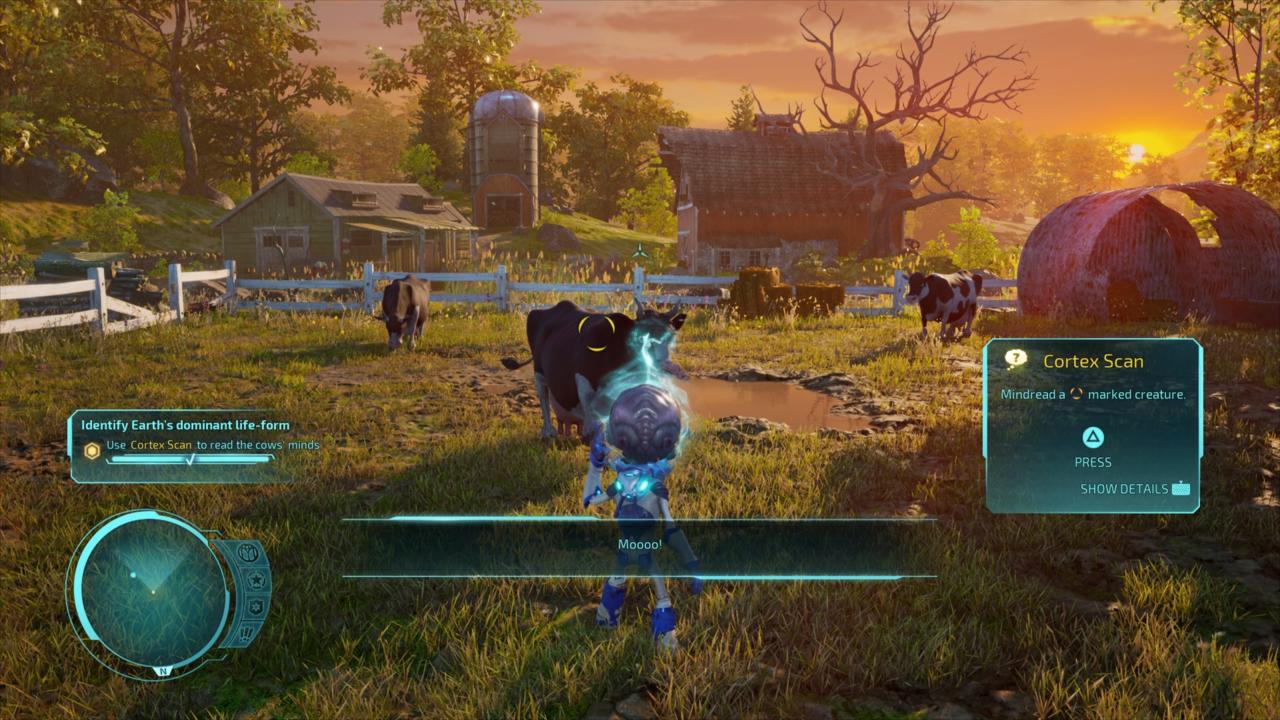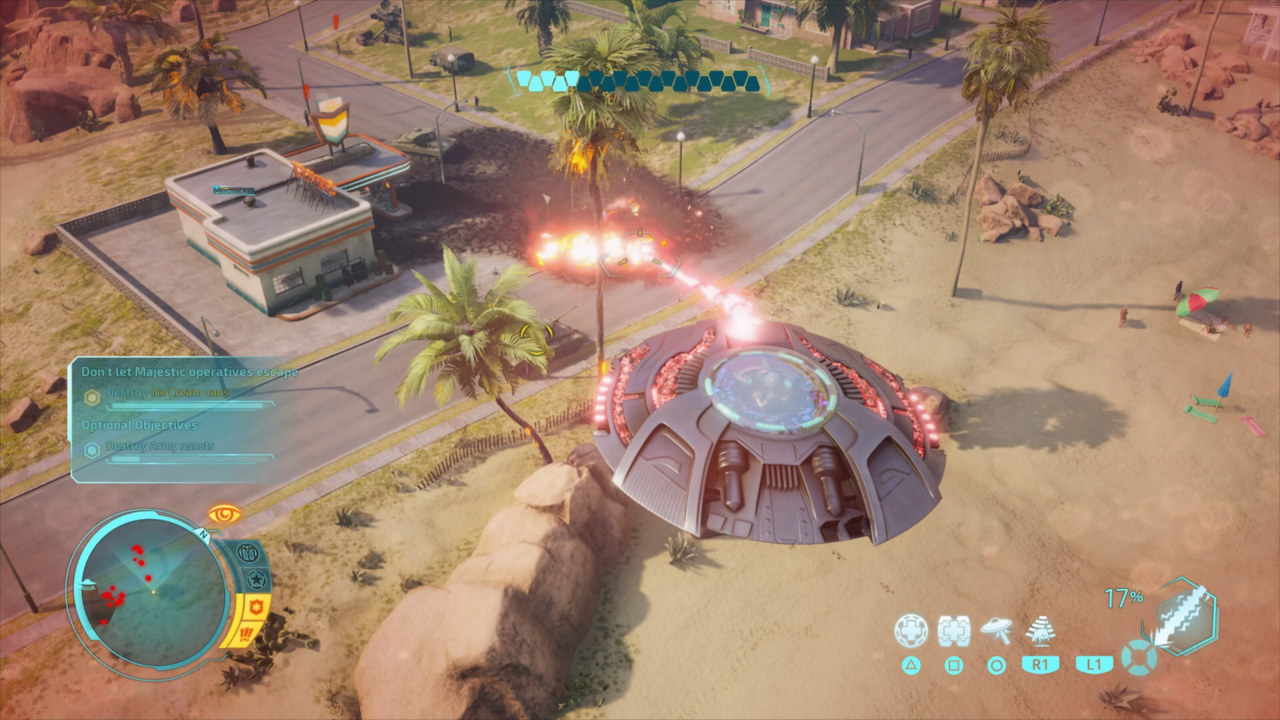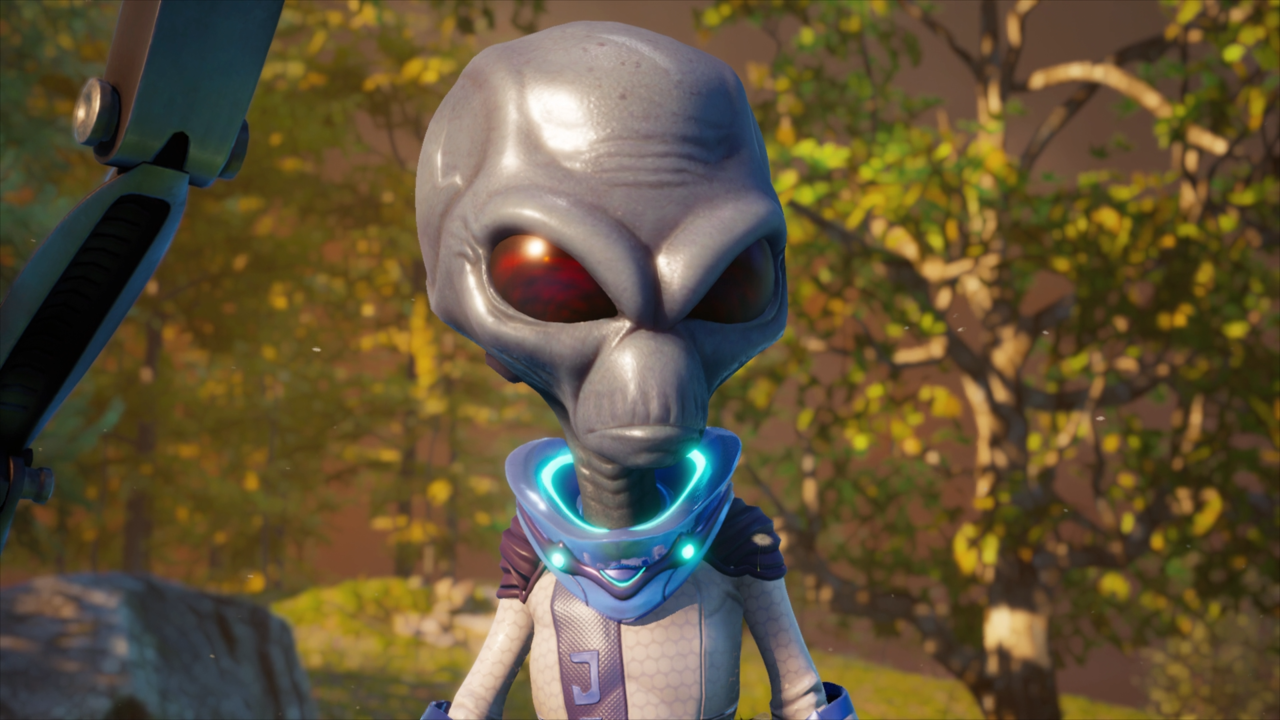I love two types of sci-fi stories: the ones that are very dark and heavy with themes about humanity's failures, and the ones that are corny and feel like the product of someone who thinks space is a playground for fun. Destroy All Humans is firmly in the second category, embracing its cheesy story and dialogue, creating an entertaining sandbox for destruction that's still satisfying 15 years after its first release, even if it's bogged down by poor audio quality and shallow stealth mechanics.
The story plays out as a B-grade sci-fi movie set in the late '50s/early '60s. Over the six hours of campaign missions you'll laugh (or groan) at the majority of jokes and bad one-liners, making for an overall enjoyable experience. The premise of two aliens completely taking over America because humans are wildly incompetent is too ridiculous to take seriously, and the game embraces the absurdity well.
The voice work from the original release helps up the camp level, but the reused dialogue raises a few issues. The audio quality is flat-out bad by modern standards; its low-fidelity really sticks out when paired with the updated graphics. The characters don't have very many lines, either, resulting in annoying repetition very early on. Be prepared to hear about communists hundreds of times before you're done.
Most of the cutscenes and dialogue are between alien protagonists Crypto and Orthopox, both of whom give strong performances, even if they feel at odds with each other. Crypto is played as a C-tier action hero, with bad one-liners that feel delivered by an uninterested actor, which is probably intentional. That clashes with the over-the-top Invader Zim-style performance given for Orthopox, which feels like he didn't get the direction for campiness that everyone else did. The clashing performances play out comedically for the most part but create some tonal whiplash whenever only one of them has a more serious moment and the other continues trying to riff.
The game's main campaign is split into missions across six maps, although one of them, Turnipseed Farms, is only used for the tutorial. Campaign missions consist of two types of gameplay: stealth and action. The stealth sections are fairly one-note, with you taking on a human disguise that needs to be occasionally refueled by brain zapping more humans. Additional obstacles, like EMP devices and Majestic Agents, force you to avoid staying in their range for too long, but don't provide much more challenge beyond zig-zagging to your objective.

The rest of the main missions involve going loud and, well, destroying all humans. Crypto is armed with four weapons and Psychokinesis, which allows you to zap, disintegrate, probe, and throw people and vehicles. A satisfying traversal ability called SKATE lets you glide around the world, and it feels very fluid. It allows you to go into a skateboard-type movement after dashing, letting you move quickly around the environment with precise steering. You can easily make quick turns and jump over objects while continuing to glide. The third-person shooting automatically locks on to enemies, allowing you to dynamically move and fire, smoothly dodging into cover or out of the way of missiles between each shot. All of the weapons have varying ammo capacities and damage levels and the weapon wheel allows for easy switching, so utilizing all of your tools during a firefight feels natural.
As more powerful enemies are introduced, you also begin to unlock more abilities and upgrades, which ensure you remain more powerful than the humans, but not to the point of being overpowered. The enemies shout silly lines about being burned or attacked and vehicles always explode when defeated, embracing the power fantasy. As you cause more destruction, your notoriety increases, leading to larger and more powerful responses from the humans. Causing mayhem and destruction is incredibly fun and when the game is at its best.
In other missions, you're instead in Crypto's saucer. Its weapons lack the variety of Crypto's own arsenal, but wrecking a town's worth of buildings still feels great. Not only do some of the weapons produce fiery leftovers, but the buildings explode into tons of pieces, which is satisfying every time. There's a lack of variety in the human enemies though, who are limited to police officers, soldiers, Majestic agents, and mutated Majestic agents. The vehicles run into a similar issue, with the only offensive vehicles being tanks and robot mechs, which, like the human enemies, rely primarily on guns. There are a fairly limited number of character models in the game and as a result, it makes the otherwise enjoyable combat encounters feel repetitive.

The campaign missions also feel disconnected. Most of them abruptly end when the objective is met, even if you're in the middle of a firefight. Not every mission ends in a cutscene either, so you may simply get kicked back to the mission select, which is jarring. Each campaign mission has anywhere from one to four optional objectives, which can involve not getting detected, killing enemies in a certain way, or destroying specific vehicles. These optional objectives add an extra twist to the combat encounters and, if missed, can easily be replayed. However, most campaign missions aren't unique enough from the rest of the game to warrant a second runthrough.
The game has three boss fights, two of which are back-to-back at the end of the campaign. These bosses go against the game's ethos of overpowered carnage seen in the rest of the game--each boss has a large health bar that needs to be drained three times to be defeated, and they take a while to get through. None of the fights are particularly challenging either--each boss only has a handful of attacks, all of which are heavily telegraphed and easily dodgeable--which makes these encounters tedious more than anything.
After playing through all of the missions available in each area, you unlock the ability to free-roam through the maps, letting you return to complete some challenges. There are four types of challenges: Armageddon, Race, Abduction, and Rampage, with one of each challenge in every map. All four of the challenges are enjoyable in their own ways, with Rampage and Armageddon tasking you with bringing destruction either on the ground or in the area using Crypto's saucer. Abduction tasks you with throwing specific objects or people into an abduction beam, which results in frantic action. Lastly, the Race challenges involve using the SKATE ability and your jetpack to quickly traverse the terrain, which shows off how well the overhauled movement system works by having you jump, jetpack, and glide behind a drone, all of which feels precise.

None of the challenges are particularly difficult, especially when you have the majority of the upgrades unlocked, which feeds into the game's power fantasy of superior beings annihilating the human race. With only 24 challenges total, the game offers just enough to experience the mayhem without feeling like a slog to finish.
Destroy All Humans certainly shows its age in places. The stealth missions are rudimentary, the boss fights are tedious, and some poor audio work won't let you forget that this is a game from 15 years ago. However, its core loop of causing destruction and mayhem, laying waste to humans and cities, still feels satisfying. Destroy All Humans often feels like the PS2 game it is, but a fresh coat of paint and updated controls definitely make this remake enjoyable to play through today.









